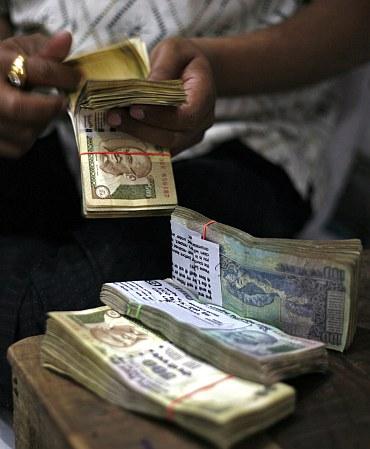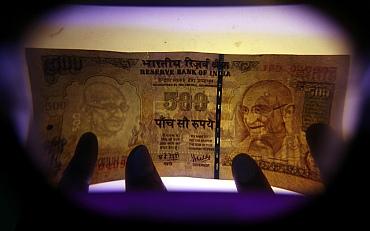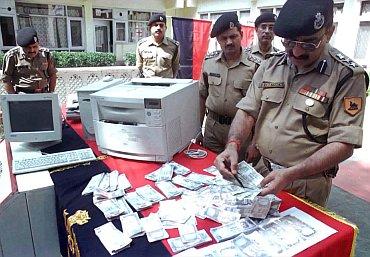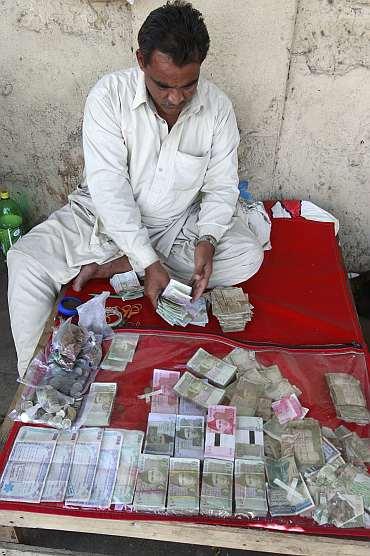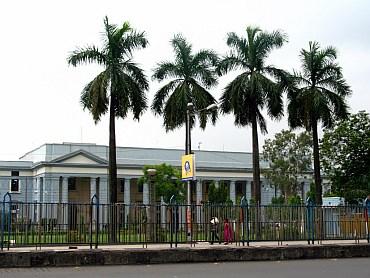 | « Back to article | Print this article |
Pak hand in fake currency racket a reality: NIA
The National Investigating Agency recently filed a 'confidential' report before the special NIA court in Mumbai. Toral Varia accesses the report submitted before the court which has several findings that nail Pakistan's role in the manufacture and circulation of fake currency notes in India.
In its supplementary chargesheet, the NIA has claimed that there has been a significant rise in the instances of counterfeit currencies being funneled into the Indian market by elements of State actors (a person acting on the behalf of the government) of some foreign country.
The report then goes on to clarify that the 'foreign country' is Pakistan.
This supplementary chargesheet has been filed against seven accused who were arrested in 2009. The NIA has also submitted further damning evidence against Pakistan in a 'confidential' report submitted to the special court.
The NIA, in its report, claims that the rise in the number of cases relating to smuggling and circulation of high value Indian currency indicates the involvement of a well-organised set-up in the production and circulation activities.
Click NEXT to read further
How the NIA established Pak role
In most cases (registered in the last two years), the FICN was either smuggled directly from Pakistan or through transit routes such as Nepal, Bangladesh and Dubai.
As part of its investigation, the NIA collected samples from several state-level investigating agencies where such cases were either solved or registered. In addition, eight samples were collected from Kerala, Bihar, West Bengal, Madhya Pradesh and Punjab.
Through the ministry of home affairs the NIA procured two samples each of legal tenders (currencies) of countries such as Pakistan, Sri Lanka, Bangladesh, Nepal, Bhutan and Myanmar, to match the quality of paper used by these countries, and those used for the counterfeit currency notes.
These samples, coupled with Pakistani currency notes, were sent to the Committee of Experts by the Security Printing and Minting Corporation of India Ltd. The initial analysis of these samples threw up some significant findings, strengthening the NIA's case.
Click NEXT to read furtherNIA claims conclusive evidence against Pakistan
Investigations have disclosed that both the fake Indian currency notes and the Pakistani currency were printed on the super simultan dry offset press.
Experts have also opined that the pH value, the wax pick quotient and the poly vinyl alcohol coating on the papers used in the fake Indian currency note samples and the Pakistani currency is highly similar, pointing towards Pakistan's involvement.
The pH value of fake currencies in the denominations of Rs 500 and Rs 1,000 was identical to Pakistani currency. Furthermore, the highly identical gram per square metre quotient of FICN samples and the Pakistani currency strongly indicate that the paper used in both -- original and counterfeit currencies -- was sourced from the same place.
According to experts, GSM is a very important indicator about the quality of the paper. The 'security thread' in the fake currency Indian notes appears to have been inserted during the manufacturing stage.
Click NEXT to read further
'India's economic security threatened'
Further analysis has shown that the duplicate currencies were printed on highly sophisticated machines available exclusively to sovereign countries, which are not accessible to the general public.
Even the printing defects indicate that the counterfeits and Pakistani legal tenders have both been generated through a common source.
The NIA claims that scientific analysis has established that certain security features of a genuine Indian currency note has been flawlessly duplicated on the counterfeits with the help of these highly sophisticated machines.
The analysis also proves that the paper used in the making of the fake Indian currencies is 100 per cent 'rag' which means it's genuine currency paper which can only be manufactured by machines exclusively owned by the State or a country.
The investigation has also revealed that the paper-making and the printing process of the Pakistani currency and the fake Indian currency is exactly similar.
"This shows the involvement of Pakistan in producing and smuggling large chunks of counterfeit into India via Dubai, Nepal, and Bangladesh, and thereby causing damage to the Indian currency and thus threatening the economic security of the country," said a top NIA official on the condition of anonymity.
Click NEXT to read further...
'Faking process has become highly sophisticated'
The source added, "The dry offset printing method is unique to every country which cannot be replicated. However, these samples have an uncanny resemblance with the currencies produced in Pakistan."
According to KP Raghuvanshi, commissioner of police (Thane), "Earlier, the perpetrators used simple computer skills that were easy to detect. But of late, the process has become highly sophisticated, and that's where the Pakistan factor comes into play."
Earlier this year, in March, the Indian government had compiled a 65-page 'secret' report, which charges officials in the Pakistan high commission in Dhaka and Kathmandu for their direct roles in manufacturing and distributing FICN.
The report also linked fake currency to at least 15 cases of terrorist funding.
